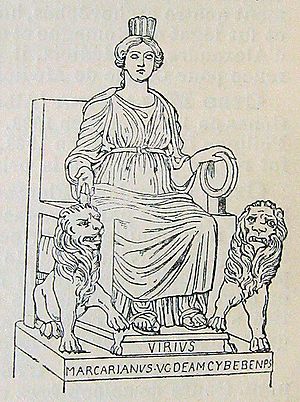Cybele facts for kids
In the ancient lands of Anatolia, people believed in a powerful goddess named Cybele. She was seen as the spirit of the earth itself. Cybele was the goddess of nature, helping plants grow and animals thrive. She also watched over mountains and wild creatures. You can often spot her in art sitting on a grand throne, with two mighty lions by her side. She usually wears a special crown that looks like city walls.
In the myths from Phrygia, a region in Anatolia, Cybele was born as a very unique being named Agdistis. This being had both male and female qualities and was said to be a child of the great god Zeus and the Earth goddess Gaia. Cybele had a special companion, a shepherd named Attis. Her worship was very important and was later adopted by the ancient Greeks and then by the Romans.
The Myth of Attis
One story tells how Zeus, while sleeping, let a seed fall onto the Earth. From this, a unique being was born, having both male and female qualities, and they called it Agdistis. The other gods were a bit afraid of Agdistis's power. So, they removed its male part. From the spot where this happened, an almond-tree grew.
Later, a daughter of the river god Sangarius picked an almond from this tree. She placed it in her clothing, and the almond mysteriously disappeared. Soon after, she had a baby boy, and they named him Attis. Attis grew up to be a handsome young man and became very important in the stories of Cybele.
Cybele's Worship
Cybele's worship was very popular in central and northwestern Asia Minor. It eventually traveled to Greece, reaching islands like Samothrake and cities like Thebes. Cybele was often linked with other Greek goddesses. She was especially close to Rhea, who was known as the mother of the gods in Greece. Sometimes, she was also connected to Demeter, the goddess of harvest, or Aphrodite, the goddess of love, and even Artemis, the goddess of the hunt.
Cybele had a special group of priests called the Galli. These priests were very devoted and celebrated her festivals with energetic dancing and acts of strong dedication. Their worship was a powerful and emotional experience for them.
Related pages
- Archigallus, the high-priest of Cybele
- Taurobolium, the sacrifice of a bull to Cybele
Images for kids
-
Cybele enthroned, with lion, cornucopia, and mural crown. Roman marble, c. 50 AD. Getty Museum
-
Cybele drawn in her chariot by lions towards a votive sacrifice (right). Above are the Sun God and heavenly objects. Plaque from Ai Khanoum, Bactria (Afghanistan), 2nd century BC. Gilded silver, ⌀ 25 cm
-
Eroded inscription from Lugdunum (modern Lyon, in France) commemorating a taurobolium for the Mother of the Gods under the title Augusta
-
Bronze fountain statuette of Cybele on a cart drawn by lions 2nd century AD. Metropolitan Museum of Art
See also
 In Spanish: Cibeles para niños
In Spanish: Cibeles para niños















